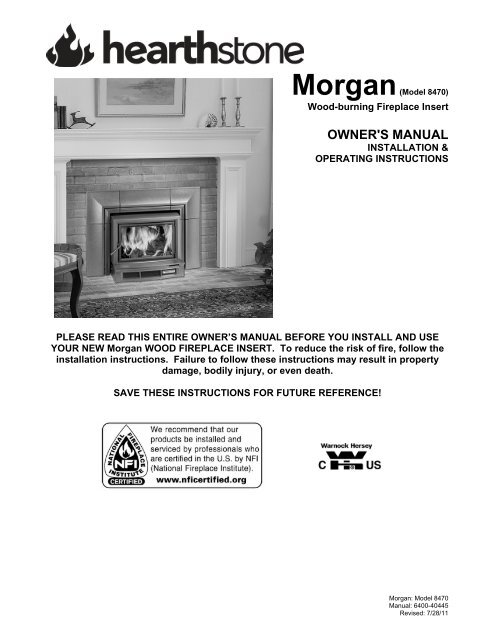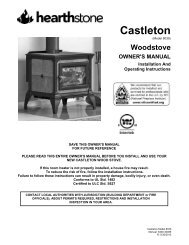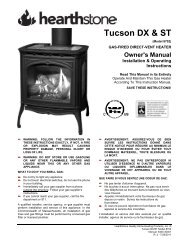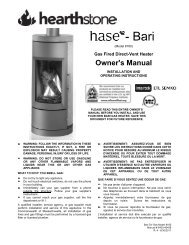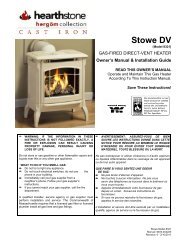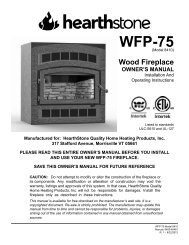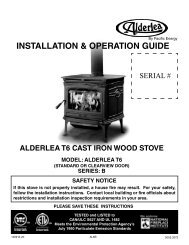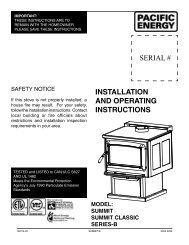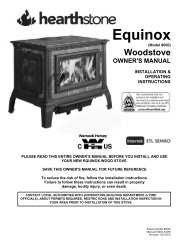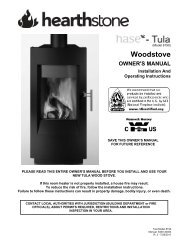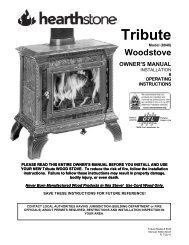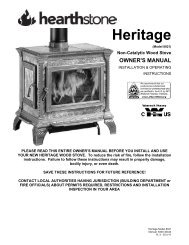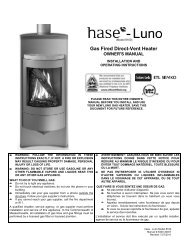Morgan 8470 Manual - Hearthstone Stoves
Morgan 8470 Manual - Hearthstone Stoves
Morgan 8470 Manual - Hearthstone Stoves
You also want an ePaper? Increase the reach of your titles
YUMPU automatically turns print PDFs into web optimized ePapers that Google loves.
CODESWhen you install your <strong>Morgan</strong> wood Fireplace Insert, it isimperative that you adhere to all local codes, which canbe obtained from either of the following two Nationalsources:American National Standards Institute, Inc. (ANSI)1430 BroadwayNew York, NY 10018Never use gasoline type fuel, kerosene, charcoallighter fluid, or other liquid fuels or solid fire startersto start or invigorate the fire. These fuels canpossibly generate carbon monoxide, which can sapthe supply of oxygen. Keep all such materials awayfrom the Fireplace Insert.Never use a wood grate or other device to elevate thefire.National Fire Protection Association, Inc. (NFPA)Battery March ParkQuincy, MA 02269SAFETY INFORMATIONRead and understand this Owner's <strong>Manual</strong>thoroughly before installing and using this FireplaceInsert.Make sure to install your Fireplace Insert: According to the manufacturer's recommendations.In accordance with all applicable codes.With the proper sized chimney.When using your Fireplace Insert: Warn children and others unfamiliar with woodstovesof the danger of touching hot, radiating surfaces ofyour Fireplace Insert. For your additional safety,obtain hearth and stove guards through your localdealer.Follow recommended break-in procedure as outlinedin this manual.Burn natural wood only. Higher efficiencies andlower emissions result when burning air-dried,seasoned wood, as compared to green or freshly cutwood.Use caution when loading firewood into a hot stove.Inspect the stovepipe, chimney connector andchimney, as recommended.Follow these safety precautions: Never modify this Fireplace Insert in any way,especially the primary air control system.Never burn kiln dried wood, painted or treated wood,solvents, trash, plywood, colored or glossy paper,artificial logs, cardboard, coal, garbage or driftwood.Especially, do not burn coal in this Fireplace Insert.2<strong>Hearthstone</strong> Quality Home Heating Products, Inc. ® <strong>Morgan</strong> Model <strong>8470</strong>Do Not allow logs to rest against or otherwise comein contact with the glass when the door is closed.Do Not slam the door or use the door to force woodin to the Fireplace Insert.Never over-fire your Fireplace InsertNever put articles of clothing or candles on a hotFireplace Insert.Do Not connect the Fireplace Insert to a flue that isserving another appliance.Other safety guidelinesKeep all combustible items such as furniture, drapes,clothing, and other items, at least 36" (0.92 m) fromthe Fireplace InsertInstall a smoke detector, preferably in an area awayfrom your wood Fireplace Insert.Keep a fire extinguisher handy. We recommend thetype rated "A B C."Dispose of ashes properly.Keep children and pets away from the stove; theycould be burned by touching a hot stove.Clean your chimney system as needed.PERIODIC CHECKLISTPerform each of these tasks at the specified intervals.At the End of Every Week: Empty ashes from the firebox (sooner if the fireboxbegins to fill up).At the Beginning of Every Other Month: A visual inspection of the chimney connector andchimney for creosote is recommended dependingupon your use of the stove. Check door seals using the "dollar bill test." - Whenthe fire is out and the stove is cool, shut the door on a
dollar bill. If the bill pulls out without any resistance,then your stove’s door isn't sealed properly. Totighten the seal, change the door gasketAt the End of Every Season: Dismantle the chimney connector and clean itthoroughly. Replace any pieces that show signs ofrust or deterioration. Inspect and, if necessary, clean your chimney. Thoroughly clean out the inside of the FireplaceInsert. Inspect all door gasket material and replace if worn,frayed, cracked or extremely hard.EMERGENCY PROCEDURESIf you have a stovepipe or chimney fire, follow theseinstructions:1. If the fire is too threatening, leave the area and callthe fire department immediately! If not, perform thenext two steps.WARNINGDO NOT ATTEMPT TO PUT OUT A STOVEPIPEOR CHIMNEY FIRE BY THROWING WATERONTO THE STOVE, STOVEPIPE, ORCHIMNEY. THE EXTREMELY HIGHTEMPERATURE ASSOCIATED WITH SUCHFIRES CAN CAUSE INSTANTANEOUS STEAMAND SERIOUS BODILY HARM.Once the chimney fire has expired, leave the primary aircontrol closed and let the fire in the Fireplace Insert dieout completely. The Fireplace Insert should not be firedagain until the Fireplace Insert, stovepipe, and chimneyare all thoroughly inspected for any sign of damage. Youmust correct any damage before using your FireplaceInsert again.To remove the <strong>Morgan</strong> for inspection purposes, simplydisconnect the venting from inside the firebox. Carefullyremove the surround from the insert, and slide the insertaway from the fireplace.2. Close the primary air control.3. Keep the Fireplace Insert door closed!<strong>Hearthstone</strong> Quality Home Heating Products, Inc. ® 3<strong>Morgan</strong> Model <strong>8470</strong>
INSTALLING THE SURROUND3421Figure 4 <strong>Morgan</strong> Surround AssemblyTo complete the assembly, you will need a Phillipsscrewdriver and a 7/16” wrench. The <strong>Morgan</strong> surroundassembly will come in four sections, with a hardwarepackage. The four sections will be:1- Right section2- Left section3- Center Top Outer section4- Center Top Inner sectionThe hardware package will include:2- ¼-20x5/8” Hex Screws4- 10-24x½” Pan, Phillips Screws2- 10-24x3/8” Flat Phillips Black Oxide Screws4- 10-24x3/8” Pan, Phillips Black Oxide Screws2- Surround Leveling BracketsUSE FIGURE 4 AS A REFERENCE, WHENASSEMBLING THE SURROUND1. Install the left and right surround brackets.2. Locate and place the Right section (1) face downon a soft surface.3. Locate and place the Center Top Inner (4) andCenter Top Outer (3) sections face down inposition adjoining the right section (1).1. Position the Center Top Inner and OuterSections (3+4) of the surround into position asillustrated in Figure 4. Secure them to the toppanel using the fasteners provide in the zip lockbag – proper placement of the screws is calledout in Figure 42. Repeat steps 1-4 with the Left section (2)4. Lift the completely assembled surround close thefront of the insert. Locate the four bushings onthe back of the surround. These four bushingswill slide into the receiving slots on the surroundmounting brackets (located on the insert)5. Lift the surround and place on the insert. Ensurethat the surround has fully seated into the slots,as the bottom of the surround should be flushwith the bottom of the insert.6. Use the leveling brackets if needed to keep thebottom edges of the surround flush to the hearth.Install the leveling brackets by bolting them intothe square cutout on the back bottom of thesurround using the 10-24x3/8” bolts provided.Turn the ¼-20 bolts down into the threaded holeson the bottom of the leveling brackets. Thesebolts can now be turned to raise the surround.<strong>Hearthstone</strong> Quality Home Heating Products, Inc. ® 7<strong>Morgan</strong> Model <strong>8470</strong>
It is very important to follow minimum clearances forchimney connectors to combustibles such as walls andceilings when installing the stove near noncombustiblesurfaces. Typical chimney connectorclearances are outlined below. The single wallclearances are generic; the Double wall clearances arefor Simpson Dura Vent DVL, CHECK THESPECIFICATIONS FROM THEMANUFACTURER OF YOUR CONNECTOR.INSTALLING A VENTING SYSTEMDO NOT CONNECT THIS UNIT TO ANY AIRDISTRIBUTION DUCT OR SYSTEMSecure all joints, including attaching the stovepipe to theFireplace Insert's flue collar, with three sheet metalscrews. Install #10 x 1/2" (3 mm x 13 mm) sheet metalscrews into the holes pre-drilled in the flue collar.Leaving off the screws can cause joints to separate fromthe vibration that results from a creosote chimney fire.Long runs of stovepipe to increase heat dispersal are notrecommended. Using longer lengths of stovepipe or moreconnecting elbows than necessary increase the chances ofdraft resistance and the accumulation of creosote buildup.Remember, the NFPA has recommended, minimumclearances for chimney connectors to combustibles suchas walls and ceilings. Once the Fireplace Insert isinstalled at safe distances from these combustiblesurfaces, it is important to maintain these connectorclearances for the remainder of the installation.CONNECTING YOUR WOOD FIREPLACE INSERTYou can install your <strong>Morgan</strong> to a prefabricated metalchimney or a masonry chimney. See figure 7 to aid inconnections.CONNECTING TO A PREFABRICATED METALCHIMNEY (A FULL FLUE LINER IS REQUIRED IN CANADA)factory-built fireplace, the fireplace must have thefollowing characteristics:1. Listed per UL 127 or ULC S610.2. Include a full height listed chimney liner meetingtype HT requirements (2100° Fahrenheit) per UL 1777(United States) or ULC S635 (Canada) standards, or witha direct flue connector into the first chimney liner section3. The means to prevent room air passage to thechimney cavity of the fireplace.4. Does not disturb the airflow in or within thefireplace when installed (louvers, or cooling air inlet oroutlet ports must not be blocked).5. Not be altered in any way, except for thefollowing:a. External trim pieces which do not affectthe operation of the fireplace can be removed, providingthey are stored on or within the fireplace for re-assemblyif the insert is removed.b. The chimney damper can be removed toinstall the chimney liner.6. Must not have blocked circulating chambers (ifavailable).7. The means for removing the insert to clean thechimney flue.8. Have a permanent metal warning label (provided withthe <strong>Morgan</strong>—see illustration to the below) attached to thefireplace by riveting it to the outside wall, stating that thefireplace must be restored to its original condition for safeuse without the insert.Remember, you must adhere to all previously describedfloor protection requirements when installing into a zeroclearance fireplace.▌ WARNING:DO NOT CONNECT THE FIREPLACE INSERTTO A CHIMNEY FLUE SERVING ANOTHERAPPLIANCE.IT IS STRONGLY RECOMMENDED THAT THISFIREPACE INSERT IS INSTALLED WITH ACONTINUOUS CHIMNEY LINER WITH AMINIMUM DIAMETER OF 6” EXTENDING FROMTHE FIREPLACE INSERT TO THE TOP OF THECHIMNEY. THE CHIMNEY LINER MUSTCONFORM TO THE CLASS 3 REQUIREMENTS OFCHIMNEY LINER STANDARDS CAN/ULC-S635 ORCAN/ULC- S640You can install the <strong>Morgan</strong> in a masonry or zeroclearance fireplace. Before installing the stove in aMake sure the size of the chimney’s flue is appropriate forthe <strong>Morgan</strong>. The <strong>Morgan</strong> requires a 6" (152 mm) insidediameter flue for new installations. A 6” diameter flueprovides adequate draft and performance. You can use an8" (203 mm) diameter existing flue with a reducer. Anoversized flue contributes to creosote accumulation. (Inthis case, bigger is NOT better.)When purchasing a prefabricated chimney to install withyour Fireplace Insert, be sure to also purchase from thesame manufacturer the wall pass-through (or ceilingsupport package), "T" section package, fire-stops (when<strong>Hearthstone</strong> Quality Home Heating Products, Inc. ® 9<strong>Morgan</strong> Model <strong>8470</strong>
needed), insulation shield, roof flashing, chimney cap,and any other needed accessories. Follow themanufacturer’s instructions when installing the chimneyand accessories. In addition, be sure to maintain allmanufacturers’ recommendations for the properclearances to the chimney.There are two ways to install a prefabricated metalchimney: An interior installation where the chimney passesinside the residence through the ceiling and roof.An exterior installation where the chimney passesthrough the wall behind the Fireplace Insert then upthe outside of the residence.Whenever possible, choose an interior chimney. Aninterior chimney heats up more quickly and retains itsheat; thus promotes a better draft and discourages theformation of creosote. An exterior chimney does notbenefit from the warmth of being surrounded by thebuilding, so it typically operates at lower fluetemperatures than an interior chimney. An exteriorchimney’s draft is not as strong and may experienceincreased creosote accumulation.REMOVE DAMPER OR WIRE IT OPENChimney CapFlue liner withrequired air spaceStainless steelchimney connectormust extend toflue linerStorm CollarAdjustable RoofFlashingMin. 8" masonrythickness in frontof smoke chamberClay tile orother LinerDamper plateremoved or fastened inopen position. Seal with non-combustible material.Masonry Chimneyor otherFloor protection in accordancewith insert listingMin. clearance allowedwith insert listingTypical InstallationFigure 7 Connecting to a chimney<strong>Hearthstone</strong> Quality Home Heating Products, Inc. ® 10<strong>Morgan</strong> Model <strong>8470</strong>
Surround CapsFigure 8 Surround Cap Kit # 94-5970510 (matte) or94-5970559 (blue/black)Most zero clearance installations will raise the <strong>Morgan</strong>approximately 6” off the hearth or floor. In order to finishthe surrounds, <strong>Hearthstone</strong> offers a surround cap kit. Seethe illustration in figure 8 to see the placement of thesurround caps .CONNECTION TO A MASONRY CHIMNEYConsider two primary elements when connecting yourFireplace Insert to a masonry chimney: the chimney itselfand the thimble where the stovepipe connects to thechimney. Use only Code approved masonry chimneyswith a flue liner.Before connecting to a masonry chimney, hire aprofessional to examine the chimney for cracks, loosemortar, and other signs of deterioration and blockage. Ifthe chimney needs repair, complete them before installingand using your Fireplace Insert. Do not install yourFireplace Insert until the chimney is safe for use.Make sure the chimney’s cleanout is complete andworking properly. To avoid a loss of draft, the cleanoutmust close off completely. If allowed to cool, yourFireplace Insert will perform poorly and creosote willbuild up in the chimney.Make sure the size of the chimney’s flue is appropriate forthis Fireplace Insert and that it is not too large. Use amasonry chimney with an 8" x 8" (203 mm x 203 mm)tile size for best results. An oversized flue will contributeto the accumulation of creosote.Use the following checklist to ensure that your masonrychimney meets these minimum requirements:Chimney wall construction: Brick or modular block at least 4" (102 mm) thick. A rubble or stone wall.Flue liner: Minimum thickness of 5/8" (16 mm). Installed with refractory mortar.At least 1" (25 mm) air space.An equivalent flue liner must be a listed chimneyliner system meeting type HT requirements or otherapproved material. Interior chimney requirements:At least 2" (51 mm) clearance to combustiblestructureFire stops must be installed at the spaces where thechimney passes through floors and/or ceiling.Insulation must be 2" (51 mm) from the chimney.Exterior chimney requirements:At least 1" (25 mm) clearance to combustiblestructure.Chimney height requirements: (See Illustration)At least 3 feet (0.9 m) higher than the highest part ofthe roof opening through which it passes.At least 2 feet (0.6 m) higher than any part of the roofwithin 10 feet (3 m) measured horizontally from thetop of the chimney. This Fireplace Insert requires aminimum chimney height of 13 feet (4 m). Themaximum allowable chimney height is 30 feet (9m).The surround must be sealed to the fireplace front or thedamper area around the chimney liner must be sealed toprevent room air from entering the chimney cavity of thefireplace.WARNING Do not remove bricks or mortar from theexisting fireplace (Exception) Masonry or steel(including the damper plate) may be removed from thesmoke shelf and adjacent damper frame if necessary toaccommodate a chimney liner, provided their removalwill not weaken the structure of the fireplace andchimney, and will not reduce protection for clearance tocombustible materials to less then required by theNational Building Code<strong>Hearthstone</strong> Quality Home Heating Products, Inc. ® 11<strong>Morgan</strong> Model <strong>8470</strong>
▌ WARNING:HOT WHILE IN OPERATION. KEEPCHILDREN, CLOTHING AND FURNITUREAWAY. CONTACT MAY CAUSE SKINBURNS.Operating Your <strong>Morgan</strong>Wood Fireplace InsertPlease read this entire chapter before lighting your firstfire. It explains the controls and features of your woodFireplace Insert, how to choose firewood, and how tobreak-in your Fireplace Insert and use it on a daily basis.CONTROLS AND FEATURESFigure 9 Reversing the DoorWARNING: ONLY OPERATE WITH DOOR FULLYOPEN OR CLOSED. IF DOORS ARE LEFT PARTLYOPEN, GAS AND FLAME MAY BE DRAWN OUT OFTHE OPENING, CREATING RISKS FROM BOTHFIRE AND SMOKEIF OPERATING WITH DOORS FULLY OPEN, YOUMUST USE THE ACCESSORY SCREEN AVAILIBLETHROUGH YOUR HEARTHSTONE DEALERIf operating with the door open, some fuels may createcarbon monoxide, which can be hazardous or fatal to yourhealth. Do not burn anything but clean dry firewoodFRONT DOOR: The front door allows you to load woodinto your Fireplace Insert; a fixed handle allows you tooperate the front door and allows you to latch the frontdoor closed. The front door can be reversed to open formeither side. To open the door, lift the handle to the 2o’clock (or 10 o’clock for RH mounted door) positionand pull the door. To latch the doors, push the doorclosed tightly then lower the handle to the 4 o’clock (8o’clock for RH mounted door) position. Pull on the doorhandle to make sure it is properly latched.Reversing the door (Refer to Figure 9)To switch the door to open from the right, simply removethe ash lip assembly, and front facade. Remove the twoPhillips head screws holding the door hinges on (A+B inFigure 9) (use caution, once the last screw is removedthe door will be loose in your hands) Be careful not tolose the two hinge rivets. Using a Phillips headscrewdriver remove the door catch (C in Figure 9) (Theremay be spacer washer behind the catch to provide anadequate seal. Remove the two screws where the hingeswill go on the left side. Rotate the door 180 degrees, andput the hinges in place. Reattach the door catch on theopposite side of the front, using the same screws andspacer washers if necessary.PRIMARY AIR CONTROL: The handle is located on thefront bottom right of the Fireplace Insert. The primary aircontrol allows you to regulate the amount of air enteringthe firebox. Generally, the more air allowed into thefirebox, the faster and hotter the rate of burn; conversely,less air creates a slower burn. To fully open the primaryair intake, push the handle as far as it will go to the righttoward the firebox; push the handle as far as it will go tothe left, away from the firebox to close the primary aircontrol.INSTALLING AND OPERATING THE OPTIONALBLOWERWhen using the optional blower, follow the instructionsthat are packaged with the blower, to install and operate.The power cord can be routed to the left or right of theinsert, assuming that you follow the instructions provided.CHOOSING FIREWOODYour <strong>Morgan</strong> Wood Heater is designed to only burnfirewood-also known as cordwood.▌CAUTION:DO NOT USE CHEMICALS OR FLAMMABLEFLUIDS SUCH AS GASOLINE, NAPHTHA,KEROSENE, CHARCOAL LIGHTER FLUID ORENGINE OIL TO START A FIRE. DO NOT USECHARCOAL, PELLETS, COAL, ARTIFICIALLOGS OR ANY OTHER MATERIALS AS FUEL;THEY ARE NOT SAFE. DO NOT BURNGARBAGE.<strong>Hearthstone</strong> Quality Home Heating Products, Inc. ® 12<strong>Morgan</strong> Model <strong>8470</strong>
The quality of your firewood affects heat output, durationof burn and performance of your Fireplace Insert.Softwoods generally burn hotter and faster, whilehardwoods burn longer and produce more coals. Densityand moisture content are two critical factors to considerwhen purchasing wood for your Fireplace Insert.The following is a list of wood species and their relativeBTU (British Thermal Unit) content. The higher the BTUthe longer the burn. Firewood with higher BTUs isgenerally considered ideal for a wood stove.HIGH: Apple, Black Birch, Hickory, Locust, White Oak,Black Beech, MesquiteMEDIUM HIGH: White Ash, Beech, Yellow Birch,Sugar Maple, Red OakMEDIUM LOW: Black Ash, White Birch, Grey Birch,Elm, Norway Pine, Pitch Pine, Black Cherry, Soft Maple,TamarackLOW: White Pine, White Cedar, Balsam Fir, Spruce,Aspen, Basswood, Butternut, HemlockMoisture content also plays a key role in the performanceof your stove. Wood freshly cut from a living tree (greenwood) contains a great deal of moisture. As you mightexpect, green wood has difficulty burning and should beseasoned before using it in your wood stove. To properlyseason green wood, it should be split, stacked and allowedto air dry for a period of one year.Stack the firewood on skids or blocks to keep it off theground, cover only the top of the stack. Plastic or tarpsthat cover the sides of the woodpile trap moisture andprevent the wood from drying. As for stacking, an oldVermonter said, "The spaces between the logs should belarge enough for a mouse to get through, but not for thecat that's chasing it."Firewood should not be stored within the FireplaceInsert's specified clearances to combustible materials.BUILDING A FIREOnce you understand the controls of your wood FireplaceInsert and have chosen the appropriate firewood, you areready to start a fire.BREAKING IN YOUR WOOD FIREPLACE INSERTIt is imperative that your Fireplace Insert be "broken in"slowly. Cast iron must be "seasoned"; over-firing a newFireplace Insert may cause castings to crack or maydamage other Fireplace Insert parts. Moisture in the13soapstone must be driven out slowly to minimize the“shock” to the stone of its first exposure to high fireboxtemperatures. In addition, the asbestos-free furnacecement must be cured slowly to insure adequate sealingand bonding.When you light your first fires, the wood Fireplace Insertwill emit some smoke and fumes. This is normal “offgassing”of the paints and oils used when manufacturingthe wood Fireplace Insert. If you find it necessary, open afew windows to vent your room. The smoke and fumeswill usually subside after 10 to 20 minutes of operation.The odor and smoke will end once the Fireplace Insert is“cured”.The first fires may produce other odors from impuritiesthat exist in the area immediately surrounding theFireplace Insert. Some of these impurities can becleaning solvents, paint solvents, cigarettes, smoke, pethair, dust, adhesives, a new carpet, and new textiles.These odors will dissipate over time. You can alleviatethese odors by opening a few windows or otherwisecreating additional ventilation around your FireplaceInsert. If any odor persists, contact your dealer or anauthorized service technician.If you adhere to the following break-in procedure, as wellas all other operating procedures in this manual, the castiron and soapstone components of your Fireplace Insertwill give you many years of trouble-free use. With use,the color of the soapstone may change and small fracturesmay appear on the surface of the stone. These changeswill only add character and distinction to your FireplaceInsert.Avoid the following conditions that can cause thesoapstone or cast iron pieces to break:<strong>Hearthstone</strong> Quality Home Heating Products, Inc. ® <strong>Morgan</strong> Model <strong>8470</strong>Do not throw wood into the Fireplace Insert.Do not use the door as leverage to force wood intothe Fireplace Insert.Do not load wood that is encrusted with ice into aburning stove as the thermal shock can causedamage.Do not use a manufactured grate. Burn the firedirectly on the soapstone that lines the bottom of thefirebox.The bottom layer of soapstone in the firebox is intendedto prevent thermal stress and should remain in place in thefire box at all times.BUILDING A BREAK IN FIRE1) Open the front door and place five or sixdouble sheets of tightly twisted newspaper
in the center of the firebox. Arrangekindling in a crisscross pattern over thenewspaper. Kindling should beapproximately ten pieces, 1/2" (13 mm) indiameter and 10" to 18" (254 mm to 457mm) long.2) Fully open the primary air control bypushing the control handle fully to the right,away from the firebox.3) Light the paper under the kindling. Leavethe front door slightly ajar momentarily untilthe kindling has started to burn and draftbegins to pull.4) Close the door and allow the fire to burn.Keep the front door closed while theFireplace Insert is in use.5) KEEP A WATCHFUL EYE ON YOURFIREPLACE INSERT to maintain a steady,low-heat fire. Your first fire should makethe Fireplace Insert warm but not hot to thetouch. At most, a few small chunks ofwood should be added to the fire to reachsafe break-in temperatures.6) Once the Fireplace Insert is warm but nothot to the touch, close the primary aircontrol by pushing it fully to the left toallow the fire to die out completely.7) Let the Fireplace Insert return to roomtemperature.Your first fire and first fire each season thereafter shouldbe built and maintained as outlined above. Your patiencewill be rewarded by a properly seasoned Fireplace Insert.NOTE: Because of the cool flue gas temperatures presentduring the break-in procedure, creosote may build upquickly. Your window may get dirty. A good hot fire willclean it. We recommend a visual inspection (and cleaningif necessary) of your stovepipe and chimney once thebreak-in procedure is completed.NORMAL OPERATIONIf your Fireplace Insert is not used continuously or has notbeen used in quite some time, follow the break-inprocedure at least once to minimize the stress of a hot fireon a cold Fireplace Insert before proceeding with normaloperation. We recommend one break-in fire at the start ofeach heating season.BUILDING A FIRE FOR EVERYDAY USE1) Open the front door and place five or six doublesheets of tightly twisted newspaper in the centerof the firebox. Arrange kindling in a crisscrosspattern over the newspaper. Kindling should beapproximately ten pieces, 1/2" (13 mm) indiameter and 10" to 18" (254 to 457 mm) long.2) Fully open the primary air control by pushing itcompletely to the right, away from the firebox.3) Light the paper under the kindling. Leave thefront door slightly ajar momentarily until thekindling has started to burn and draft begins topull.4) Close the door and allow the fire to burn.5) Once the kindling is burning, open the front doorand add logs, small at first, to build the fire up.Make sure to keep the logs away from the glassin front in order for the air-wash system to workproperly. Otherwise, keep the door closed whilethe stove is in use.6) Once the fire is burning well, use the primary aircontrol to regulate the desired rate of burn.Pushing the handle to the right opens thePRIMARY AIR CONTROL for a high rate ofburn or pushing it to the left for a low rate ofburn.Note: When opening the front door to reload orre-arrange logs, it is advisable to open the door justa crack, pause for a moment then open the doorcompletely. This procedure will allow the fireboxto clear of smoke before the door is opened fully.Also, reloading on a bed of hot, red coals reducessmoking time and will bring fresh fuel up to a hightemperature rapidly.OVER-FIRE CAUTIONOver-firing means the Fireplace Insert is operating attemperatures above the recommended temperaturesoutlined above in the BURN RATE section. Over-firingshould be carefully avoided since it will cause damage tothe Fireplace Insert. Symptoms of over-firing includeshort burn times, a roaring sound in the Fireplace Insert orstovepipe, and discoloration of the stovepipe.Over-firing can be caused by excessive draft,inappropriate fuel, and operator error. Correct an overfiresituation as follows:<strong>Hearthstone</strong> Quality Home Heating Products, Inc. ® 14<strong>Morgan</strong> Model <strong>8470</strong>
EXCESSIVE DRAFT: Contact your dealer tohave a draft reading taken. Any draft in excess of 0.1 wcrequires a damper in the stovepipe. Some installationsmay require more than one damper.INAPPROPRIATE FUEL: Do not burn coal,kiln dried lumber, wax logs or anything other than naturalcordwood.OPERATOR ERROR: Make sure all the gasketsare in good condition. Replace worn out or compressedgaskets. Do not burn the Fireplace Insert with the frontdoor in the open position.Monitoring the temperature of the surfaces is the best wayto determine if the Fireplace Insert is over-firing. If yoususpect that your Fireplace Insert is over-firing, contactyour dealer immediately. Damage done by over-firingis not covered by your warranty. Results of over-firingcan include: warped or burned out internal parts, crackedstones, discolored or warped external parts, and damagedenamel.NOTE: ANY SYMPTOMS OF OVER-FIRINGWILL VOID YOUR WARRANTY!!MAINTENANCEDo not over-fire the Fireplace Insert. (refer to page 14).The stovepipe connector and chimney should be inspectedat least monthly during the heating season to determine ifa creosote build-up has occurred. If a creosote residuegreater that 1/4" (6 mm) has accumulated, it should beremoved to reduce the risk of a chimney fire.If your glass is remaining dirty, your operatingtemperatures are low; therefore, there is a higher risk ofcreosote buildup.The venting system must be inspected at the FireplaceInsert connection and at the chimney top. Cooler surfacestend to build creosote deposits quicker, so it is importantto check the chimney at the top (where it is coolest) aswell as from the bottom near the Fireplace Insert.Accumulated creosote should be removed with a cleaningbrush specifically designed for the type of chimney in use.A certified chimney sweep should be used to perform thisservice. Contact your dealer for the name of a certifiedchimney sweep in your area (your dealer may be acertified sweep!).It is also recommended that before each heating seasonthe entire system be professionally inspected, cleaned andrepaired, if necessary.CREOSOTE FORMATION AND NEED FORREMOVALWhen wood is burned slowly, it produces tar and otherorganic vapors, which combine with expelled moisture toform creosote. These creosote vapors condense in therelatively cool chimney flue of a slow-burning fire. As aresult, creosote residue accumulates on the flue lining.When ignited, this creosote makes an extremely hot fire,which may damage the chimney or even destroy thehouse. When burning wood, the chimney connector andchimney should be inspected at least once every twomonths during the heating season to determine if acreosote buildup has occurred.To prevent the buildup of creosote:1. Burn the Fireplace Insert with the primary aircontrol fully open for 35 - 45 minutes daily to burn outcreosote deposits from within the Fireplace Insert and theventing system.2. After reloading with wood, burn theFireplace Insert with the primary air control fully open for20 to 30 minutes. This manner of operation ensures earlyengagement of the secondary combustion system which,when engaged, minimizes creosote buildup in thechimney.15GASKETSGasket material should normally be replaced every two tothree seasons, depending on Fireplace Insert use. If thedoor seal is loose, a new gasket will assure a tight sealand improved Fireplace Insert performance. Contact yourdealer for a gasket kit that includes instructions andgaskets for your Fireplace Insert.The procedure for replacing gaskets on the glass isreviewed below under “Glass”.To replace door gaskets, first remove the old gaskets witha utility or putty knife. Clean all gasket channels with awire brush. Apply gasket cement to the channels andpush the new gasket into place without stretching thegasket material. The door should be shut immediately tofully press the gasket into place and assure a positive seal.GLASSDo not operate the Fireplace Insert with a broken doorglass. Do not abuse the front door by striking orslamming.When necessary, the glass can be cleaned with lowalkaline content commercial stove glass cleaners, which<strong>Hearthstone</strong> Quality Home Heating Products, Inc. ® <strong>Morgan</strong> Model <strong>8470</strong>
are available from your local dealer. Never attempt toclean the glass while the fire is burning or the glass is hot.Most deposits can be cleaned by following theinstructions provided with the cleaner. To clean heavierdeposits, remove the top hinge and lift the door straightup and off the Fireplace Insert (take care to save hardwarefor reuse). Lay the door face down on a workbench ortable. Apply the cleaner to the glass and allow it to set fora few minutes. By laying the door flat, it will allow thecleaner to penetrate rather than running off the surface ofthe glass. Wipe the cleaner off with a soft cloth.Important: scratching or etching the glass willweaken the integrity of the glass. Do not use arazor blade, steel wool, or any other abrasivematerial to clean the glass. Use low alkalinecontent cleaners only.The front door glass is a ceramic, shock-resistant glass,made specifically for use in woodstoves. Do not use anyreplacement glass other than the ceramic glassmanufactured and supplied for use in this woodstove.Replacement glass is available through your local dealer.The door glass should be replaced immediately if broken.Contact your local dealer for replacement glass, which isaccompanied with instructions and everything needed forthe repair. If you replace the glass yourself, wear workgloves and safety glasses.The procedure for glass and glass gasket replacement is asfollows: Refer to Figure 9.1. Remove the door by removing the top hingescrew and lifting the door straight up off thebottom hinge.2. Place the door face down on a flat, smoothsurface.3. Apply penetrating oil to the screws.. Remove thescrews to separate the glass from the door.4. Carefully lift the damaged glass from the doorand discard.5. Replace the screws.6. Install the door.WARNING Do not use substitute materials whenreplacing the glass or any door components. Onlyauthorized <strong>Hearthstone</strong> components should be used.Glass specifications 18-1/2” x 12” x5mm neoceramTAPE GASKET (3160-080)DOOR, INNER FRAME (5470-040)GLASS (3030-039)DOOR, OUTER FRAME (5470-042)Figure 10 Glass ReplacementCAST IRON#8-32 x 3/8 S-TAP SCREW (8x)( 2 PER SIDE)Exterior cast iron parts are either painted with black, hightemperaturestove paint or porcelainized with an enamelfinish in various colors.Use black, high-temperature stove paint (satin black byStovebright) to touch up and maintain the originalappearance of painted cast iron. Use a damp sponge towipe clean. Dry the cast iron thoroughly to preventrusting.Enamel castings can be cleaned with a standard glasscleaner. With time and use, a very fine, subtle network ofcrazed lines may appear seemingly beneath the surface ofthe enamel. Crazing is a natural predictable process anddoes not represent a flaw.TROUBLESHOOTINGYour Heating NeedsVirtually all woodstove operators experience basiccommon problems at one time or another. Most arecorrectable and generally require only a minor adjustmentof the stove, installation, or operating technique. In caseswhere weather conditions dramatically affect stoveperformance, the problems are typically temporary andsolve themselves once the weather changes.If you question whether your Fireplace Insert is producingadequate heat, the best way to troubleshoot the problem isto monitor the temperature of the stack. A 400 degree F<strong>Hearthstone</strong> Quality Home Heating Products, Inc. ® 16<strong>Morgan</strong> Model <strong>8470</strong>
(200 degree C) stovepipe confirms the Fireplace Insert issupplying sufficient heat. Keep in mind that your houseitself will regulate room/house temperatures. How wellthe walls, floors and ceilings are insulated, the numberand size of glass windows, the tightness of outside doors,and the construction or style of your house (vaultedceilings or other open spaces which collect largepercentages of heat, ceiling fans, etc.) all are determiningfactors of room temperature.Your Fireplace Insert's performance is also dependant onits installation. One common cause of poor performanceis an oversized chimney flue. Oversized chimney fluesresult in decreased pressure, which prevents the smokefrom rising out the chimney. Oversized flues are alsomore difficult to heat effectively, especially when burninga high efficiency Fireplace Insert. Cool flue temperaturesinhibit the establishment of a strong draft (and encouragethe accumulation of creosote). The lack of a strong draftwill cause the fire to die down and may even force thesmoke to pour into the room. If your chimney is theproper size and a strong draft is not easily established,there is the possibility of the chimney being too cold.Again, hot chimneys promote a stronger draft.stovepipe joints, a poor stovepipe-to-thimble connection,or a leaky chimney may cause inadequate draft.SEASONAL FACTORS: Early fall and late spring aregenerally difficult seasons in which to establish properdrafts. The colder the outside air is (relative to roomtemperatures) the stronger the draft.Operating the Fireplace InsertThere are days when a draft is not easily established. Asoutlined above, seasonal factors or a cold chimney may bethe cause. Try starting the fire by using small kindlingand fuel to obtain a quick, hot fire. Tend the firefrequently with small fuel until the chimney is hot and thedraft is well established.DISPOSAL OF ASHESAshes should be placed in a metal container with atight fitting lid. The closed container of ashes shouldbe placed on a non-combustible floor or on theground, well away from all combustible materials,pending final disposal. If ashes are disposed of byburial in soil or otherwise locally dispersed, theyshould be retained in the closed container until allcinders have thoroughly cooled.Other draft guidelines are as follows:AN "AIRTIGHT" HOUSE: If your home is superinsulatedor especially well sealed, the (infiltration) airsupply to the interior of the house may be inadequate.This phenomenon of air starvation within the building canbe exacerbated if exhaust fans, such as clothes dryers,bathroom fans or cookstove exhaust fans, are in operationwithin the home.TALL TREES OR BUILDINGS: These obstructions,when located in proximity to the top of the chimney cancause chronic or occasional downdrafts. When selectinga site for a new chimney, take care to consider theplacement of other objects near the proposed chimneylocation.WIND VELOCITY: Generally, the stronger andsteadier a wind, the stronger (better) the draft. However,"gusty" wind conditions may cause erratic downdrafts.BAROMETRIC PRESSURE: Chimney drafts aretypically sluggish on balmy, wet or muggy days. This is aweather-related phenomenon, which generally is selfcorrectingas the weather changes.BRISKNESS OF FIRE: The hotter the fire in yourFireplace Insert, the hotter your chimney and, therefore,the stronger the draft.BREAKS IN THE VENTING SYSTEM: An unsealedclean-out door at the bottom of the chimney, leaky<strong>Hearthstone</strong> Quality Home Heating Products, Inc. ® 17<strong>Morgan</strong> Model <strong>8470</strong>
TROUBLESHOOTING GUIDEPROBLEM POSSIBLE CAUSE SOLUTIONSSTOVE SMOKES Operating Technique Fully open the primary air control one minute before opening doors.Cold ChimneyPreheat the chimney when first starting a fire.Blocked ChimneyExamine the chimney and stovepipe for blockage or creosoteaccumulations.Oversized Chimney Reline the chimney to the appropriate diameterUndersized Chimney Install a draft inducer or replace the chimney.Chimney Too Short Lengthen the chimney.Air Infiltration Into The Seal chimney connections and openings in clean-out doors.ChimneyMore Than One Appliance Disconnect all other appliances and seal openings.BACK-PUFFING ORGAS EXPLOSIONSUNCONTROLLEDOR SHORT BURNINSUFFICIENT HEATBLISTERING OFENAMEL CASTINGConnected to the FlueOperating TechniqueExtra Low Burn RateChimney Down-draftExcessive Ash Build-upUnsealed or Open DoorExcessive DraftDeteriorated Cement SealsExtra Long ChimneyOversized ChimneyHigh Winds or HilltopLocation:Excessive DraftPoor Quality or GreenWoodLow Burn RateAir Insulated ChimneyCold Exterior ChimneyLeaky Stovepipe orChimneyToo Much Heat Loss FromHouseOperating TechniqueExcessive DraftFully open the primary air control one minute before opening thedoor and keep it fully open for a few minutes after reloading.Burn the Fireplace Insert at a higher burn rate.Install a chimney cap.Empty ashes more frequently.Close the door tightly or replace the gaskets.Check the installation. Operate at LOW BURN. Install stovepipedamper.Reseal the Fireplace Insert with furnace cement.Shorten the chimney. Install stovepipe damper.Reline the chimney to the proper diameter.Install a chimney cap.Draft in excess of 0.1 wc should be corrected with a stovepipedamperUse only air-dried wood, preferably dried at least one year.Operate the Fireplace Insert at a higher burn rate.Replace with a pre-fabricated insulated chimney system or aproperly sized masonry chimney.Reline or insulate the chimney.Check the installation.Caulk windows, seal openings in home.Do not over-fire the Fireplace Insert. Monitor Fireplace Inserttemperatures. Use seasoned wood only.Check the DRAFT. A damper may be required. Operate theFireplace Insert at a LOW BURN range.<strong>Hearthstone</strong> Quality Home Heating Products, Inc. ® 18<strong>Morgan</strong> Model <strong>8470</strong>
REPLACEMENT PARTS & OPTIONAL ACCESSORIESPART NUMBER: DESCRIPTION: PART NUMBER: DESCRIPTION:CASTINGS:STEEL PARTS:2410-700 BOTTOM (REAR SECTION)5470-0055470-010LEVELING SKIDLEVELING CHANNEL2410-705 BOTTOM (FRONT SECTION) 5470-015 BOTTOM AIR SHROUD2410-710 PRIMARY AIR SLIDER 5470-020 PRIMARY AIR HANDLE2410-715 BACK2410-720 LEFT SIDE 5470-025 LOWER SURR. BRACKET, LEFT2410-725 RIGHT SIDE 5470-027 LOWER SURR. BRACKET, RT2410-730 ASH LIP/BLOWER, LEFT5470-028 FRONT ASH LIP BRKT, LEFT5470-030 FRONT ASH LIP BRKT, RT2410-732 ASH LIP/BLOWER, RIGHT 5470-032 WINDOW SILL BRACKET2410-735 ASH LIP/BLOWER, FRONT2410-740 ASH LIP/BLOWER, TOP 5470-034 ASH LIP SCREEN2410-750 PRIMARY AIR MANIFOLD 5470-035 REAR AIR SHROUD2410-760 FRONT 5470-040 DOOR INNER FRAME2410-765 FRONT FAÇADE 5470-042 DOOR, OUTER FRAME2410-770 SECONDARY AIR MANIFOLD 5470-045 HINGE2410-780 TOP (REAR SECTION) 5470-049 SURR. CONNECTOR PLATE2410-785 TOP (FRONT SECTION) 5470-050 DOOR CATCH2410-790 FLUE COLLAR 5470-055 FIRE BRICK CLIP, REAR5470-057 FIRE BRICK CLIP, SIDESOAPSTONE: 5470-060 SECONDARY AIR SUPPORT, L0000-101 SOAPSTONE 4-1/2” X 9” 5470-062 SECONDARY AIR SUPPORT, R0400-700 SOAPSTONE 4” X 9” 5470-065 SECONDARY AIR COLLAR0400-701 SOAPSTONE 1-1/2” X 8-1/2” 5470-070 SECONDARY AIR CAP, LEFTMISC: 5470-072 SECONDARY AIR CAP, RIGHT5470-052 DOOR HANDLE 5470-081 SECONDARY AIR TUBE #13900-177 WOODEN DOOR HANDLE 5470-082 SECONDARY AIR TUBE #25470-083 SECONDARY AIR TUBE #33120-470 BAFFLE FIBERBOARD 5470-084 BAFFLE BRACKET3030-039 FRONT DOOR GLASS 5470-085 BAFFLE SUPPORT S.S.2410-795 INNER SURR. STRAIGHT 5470-095 TOP AIR SHROUD2410-797 INNER SURR. CORNER 5470-097 INNER SURR. CONN. PLATE2410-798 OUTER SURR. STRAIGHT 5947-020 OUTER SURR. CONN. PLATE2410-799 OUTER SURR. CORNER<strong>Morgan</strong> Accessories:94-57700 Blower Assembly94-5970510 Matte Surround Caps94-5970559 Blue/black Surround Caps94-79700 Mantle Shield94-69700 Screen Kit94-5970010 Surround Extension94-5970710 Matte Double Surround Caps94-5970759 Blue/black Double Surround Caps<strong>Hearthstone</strong> Quality Home Heating Products, Inc. ® 19<strong>Morgan</strong> Model <strong>8470</strong>
SAFETY LABELCONTACT YOUR LOCAL BUILDING OFFICIALS ABOUT RESTRICTIONSAND INSTALLATION INSPECTION IN YOUR AREAListed Room Heater, Solid Fuel TypeIntertek TestingServices NA, inc.WN 04380“PREVENT HOUSE FIRES”Install and use only in accordance withmanufacture’s installation instructions andyour local building codes.Connect to a code-approved masonry chimneyor listed factory-built fireplace chimney with adirect flue connector into the first chimney linersection.CAUTION: Special methods are required whenpassing chimney through a wall or ceiling, referto local building codes. Do not connect this unitto a chimney flue serving another appliance.NOTE: Replace glass only with 5mm CERAMICor NEOCERAM glass.SIDEWALLBFront ViewASTOVETop ViewCTRIMManufactured by:317 Stafford Ave.Morrisville VT 05661SERIAL #MODEL NAME: MORGAN <strong>8470</strong>TESTED TO: UL 1482, ULC S628, UL 737TYPE OF FUEL: Solid Wood OnlyWARNINGS:Risk of smoke and flame spillage,operate only with doors fully openor fully closed.Do not obstruct space under heater.Do not use grate or elevate fire. Buildwood fire directly on stone.Do not overfire. If the heater orchimney connector glows, you areoverfiring.Clearance to Combustible Materials*“TRIM” is defined as any combustibleprotruding 1/2” or less from the wall.A - 34” (87cm)A - 22” (56cm) with Mantle ShieldB - 13” (33cm)C - 3” (8cm)D - 34” (87cm)E - 16” (41cm)When installed on a combustible floor,non-combustible floor protection, with aR value of 1.0 or greater, is required tocover the area beneath the heater, 16” infront of, and 8” beyond both sides of theglass opening. (See “Top View” diagramSTOVEHEARTHD* Refer to the Installation <strong>Manual</strong> foradditional clearance information.EOPTIONAL KITS:Mantle Shield Kit Kit # 94-79700Screen Kit # 94-69700Blower Kit # 94-57700Surround Caps Kit # 94-597051Surround Extension Kit # 94-5970010CAUTION: HOT WHILE IN OPERATION. DO NOT TOUCH. KEEPCHILDREN, CLOTHING AND FURNITURE AWAY. CONTACT MAYCAUSE SKIN BURNS. SEE NAMEPLATE AND INSTRUCTIONS.INSPECT AND CLEAN CHIMNEY AND CONNECTORFREQUENTLY. UNDER CERTAIN CONDITIONS OF USE,CREOSOTE BUILDUP MAY OCCUR RAPIDLY.U.S. ENVIRONMENTAL PROTECTION AGENCYCertified to comply with July 1, 1990 particulate emissions standardsDate of Manufacture2003 2004 2005 Jan Feb Mar Apr May Jun Jul Aug Sep Oct Nov DecDO NOT REMOVE OR COVER THIS LABEL MADE IN USA 3300-615<strong>Hearthstone</strong> Quality Home Heating Products, Inc. ® 20<strong>Morgan</strong> Model <strong>8470</strong>
WARRANTY REGISTRATIONThe Original Purchaser may send a completed and signed Warranty Registration Form, which is enclosed in theWoodstove warranty packet, to the following address:<strong>Hearthstone</strong> Quality Home Heating Products, Inc.Warranty Department317 Stafford AvenueMorrisville, VT 05661NOTE: SENDING IN THE SIGNED WARRANTY REGISTRATION FORM IS NOT A CONDITION OFWARRANTY COVERAGE OR HEARTHSTONE’S PERFORMANCE.<strong>Hearthstone</strong> Quality Home Heating Products, Inc. ® 21<strong>Morgan</strong> Model <strong>8470</strong>
Preparing the <strong>Morgan</strong> Wood Insert for installation(Refer to Owner’s <strong>Manual</strong> for the complete installation instructions)1. Remove the contents within the firebox (owner’s manual, baffle and soapstone refractory box)Remove the hang tag on the front door and place in the owners manual)2. Using a ½” and 7/16” wrench, remove the leftand right pallet mounting clips. (Keep the ¼-20bolt with a 7/16” head, as it will be used toinstall the surround bracket) discard the palletHeat Shield3. Using a Phillips head screwdriver remove the four screwsholding the top heat shield on. Pull the heat shield away from theunit and remove the flue collar.4. Remove the ash lip assembly byloosening (NOT REMOVING) theforward Phillips head screw on bothsides of the assembly and pullingaway from the unitAsh lipclamping bolt5.Remove the front façade by lifting and pulling away from the unit.<strong>Hearthstone</strong> Quality Home Heating Products, Inc. ® 22<strong>Morgan</strong> Model <strong>8470</strong>
Front facade6. Open the large cardboard boxcontaining the surround kit. Locatethe left and right surround brackets.Start the ¼-20 bolt through theslotted opening on the surroundbrackets, and attach to the sides ofthe unit. Set the surround brackets inthe approximate position that theSurround bracket(Right)7. Determine the forward/aft position of the flue collar and remove the circle on the top heat shield that willallow the flue collar to connect to the liner. (TIP Ensure that the connector you are using will fit through theopening in the top heat shield before installing the insert)Forward positionAft position8. Reinstall the top heat shieldFlue collar shown in the aft position (you willinstall it later9. Place the unit in position, within the fireplace<strong>Hearthstone</strong> Quality Home Heating Products, Inc. ® 23<strong>Morgan</strong> Model <strong>8470</strong>
10. Level the unit using a 9/16” and 7/16” wrench or ratchet on the three leveling bolts. (To level the rearbolt, you must first loosen the jam nut at the base of the bolt)Leveling bolts11. Attach the liner (See Owner’s <strong>Manual</strong> for complete instructions)a. Pull the flue liner into the firebox through the flue opening on top of the insert and attach to the fluecollar.b. Locate the hardware kit in the owner’s manual envelope. Once attached to the liner, push the fluecollar up and attach to the under side of the top castings. Mount the flue collar with the four ¼-20 nutsand washers provided in the hardware kit.This end up !Reversable Flue(Front-Back)3/8"Mediumdensitygasket<strong>Hearthstone</strong> Quality Home Heating Products, Inc. ® 24<strong>Morgan</strong> Model <strong>8470</strong>
12. Attach the surround to the unit. (The Owner’s <strong>Manual</strong> contains full instructions on how to install)342113. Mount the baffle in placeNote: The baffle material is a high temperature ceramic. It will last for years under normal use,however it can be easily damaged by impact or force. BE CAREFUL IN HANDLING, TOAPPLY PRESSURE TO THE TUBES AND CAST IRON ONLY!a. Place the baffle inside the stove with the ceramic board facing up, and the stainless steel shelf tabsforward.b. Lift the baffle and slide the baffle sleeves, on the rear of the baffle, into the slots on the rear of the unit.c. Push in until the sleeves are completely in the slots.d. Gently lower the front of the baffle until the shelf tabs are resting on the side wall.e. To verify that the baffle is in correct position, gently tug down on the front of the baffle. If it does notcome down. It is in the place.BafflesleevesShelf tabs<strong>Hearthstone</strong> Quality Home Heating Products, Inc. ® 25<strong>Morgan</strong> Model <strong>8470</strong>
14. Locate and mount the front door handle using the 3” bolt and lock washers provided.15. Install the soapstone firebricka. BEFORE INSTALLING ANY SOAPSTONE, USE A 7/16” WRENCH TO REMOVE THETHREE STONE RETAINER CLIPS. (The rear clip is not shown below)b. Put the four side stones in place and reattach the retainer clips.c. Put the three rear stones and reattach the long rear retainer clip.d. Place the remaining stones on the floor of the unit referring to the figure below.Stone retainerclips1 1 12 223 3121 1 2Reference# Qty Size___1 6 9” x 4-1 /2”2 5 9” x 4”3 2 8-1/2” x 1-1/2”<strong>Hearthstone</strong> Quality Home Heating Products, Inc. ® 26<strong>Morgan</strong> Model <strong>8470</strong>
NOTE: If you plan on installing a blower, now is the time to install it, prior to reassembling the unit.16. The door to the <strong>Morgan</strong> is reversible. It can be opened from the left hand side, or the right. It will be shipped from<strong>Hearthstone</strong> opening on the left hand side. To switch the door to open from the right, simply remove the ash lip assembly,and front facade. Remove the two Phillips head screws holding the door hinges on (use caution, once the last screw isremoved the door will be loose in your hands) Be careful not to lose the two hinge rivets. Using a Phillips headscrewdriver remove the door catch (There may be spacer washer behind the catch to provide an adequate seal. Remove thetwo screws where the hinges will go on the left side. Rotate the door 180 degrees, and put the hinges in place and mountReattach the door catch on the opposite side of the front, using the same screws and spacer washers if necessary.17.Replace the front façade by simply lifting it over the opened door and ash lip and setting it back in place.18. Replace the ash lipassembly (NOTE: Prior toreplacing the ash lip assembly,you must first ensure that theair control handle. is centered inits motion.) Lift and slide theassembly back on to the ash lipclamping bolts. The ash lip ison when the back is tight to thefront façade. Once on, tightenthe ash lip clamping bolts.Air control handle<strong>Hearthstone</strong> Quality Home Heating Products, Inc. ® 27<strong>Morgan</strong> Model <strong>8470</strong>


